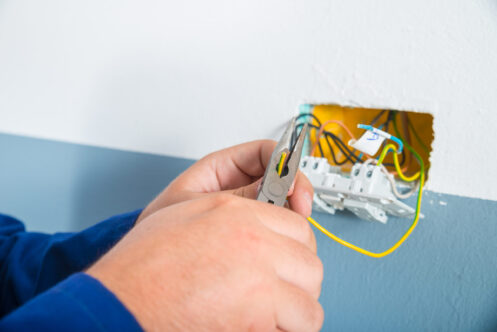
Having access to a nearby outlet is important when doing all sorts of outdoor projects. For one thing, being able to plug directly into an outlet is much more convenient than having to use an extension cord. There are also times when the closest outlet is so far away that you need to connect multiple extension cords together, which can be a major safety hazard.
The Risks of DIY Electrical Work
Whether it’s installing a new outdoor outlet or anything else, it’s always worth paying a licensed electrician to do the work. DIY electrical work can be extremely dangerous. There’s no chance of getting electrocuted when performing the work as long as you make sure to shut the power off first.
However, there is a chance of someone getting shocked or electrocuted once the power is back on if the outlet isn’t properly grounded. An even bigger concern is that improper wiring can result in an electrical fire and potentially burn your house down.
Another thing you should be aware of is that your homeowner’s insurance won’t cover fire damage if the fire results from improper DIY electrical work. It’s also extremely likely that they’ll drop your coverage, in which case you’ll have a much harder time getting a new insurance policy. You will also almost certainly have to pay much higher premiums as well.
Do You Need a Permit to Add a New Outdoor Outlet?
Most cities and counties require you to get a permit before adding to the existing electrical, modifying/moving any wiring or doing anything other than very minor electrical work. That means you’ll generally always need to obtain a permit when installing any new outlets inside or outside your home. The local electrical inspector will also have to inspect the work once it’s complete to ensure it meets the relevant electrical code requirements.
In most places, only a licensed electrical contractor can apply for and receive the necessary permit. In addition, the only way the work will pass inspection is if it was performed by a licensed electrician.
Not getting a permit if required can lead to major issues for you down the road. For one thing, it can create extra hassles if you want to sell your house and the work doesn’t meet code. You also typically get fined if the city or county ever finds out you didn’t get the required permit.
Factors to Consider When Installing an Outdoor Outlet
The first step, when installing a new outdoor outlet, is to choose the location and determine the best or easiest way to run power to it. The easiest option is to tie into an indoor outlet and then install the outdoor outlet in the same location on the exterior of the wall.
Going this route makes it simple to run the wiring from the indoor outlet to the outdoor outlet through a hole in the wall. It also eliminates the need to cut any holes in a wall or ceiling. The only thing to note is that electrical code prohibits tying an outdoor outlet to any indoor outlet in the kitchen, bathroom or laundry room.
If there aren’t any nearby indoor outlets where you want the outdoor outlet, you can run the wiring from a junction box in the basement or crawl space. Another option is to still connect to an indoor outlet and then install a metal conduit on the outside of the house to run the wiring from the indoor outlet to the outdoor outlet. You may also just be able to run a conduit and connect the new outlet to an existing outdoor outlet.
You also need to consider what you’ll be using the outdoor outlet for and how much power you need. One reason is to avoid overloading the circuit when using the outdoor outlet and tripping the breaker. If you plan on using the outdoor outlet for things like a trimmer, an electric mower or larger power tools, you’re always better to connect it to a 20-amp circuit instead of a 15-amp circuit to reduce the chances of overloading the circuit.
Most homes only have a few 20-amp circuits in places like the kitchen and garage. As such, it may be necessary to install a new 20-amp circuit and run wiring from the electrical panel to the outdoor outlet through the basement, crawl space or an exterior wall.
The Process of Installing an Outdoor Outlet
Once an electrician determines how they’re going to tie the new outlet into your electrical system, the rest of the installation process is fairly straightforward. They’ll start by turning off the power, which normally just means switching off the breaker for whichever circuit the new outlet will be on. If they need to install a new circuit for the outlet, they’ll instead have to switch off the main breaker and shut off the power to the entire house.
If the new outlet is being tied into an existing indoor or outdoor outlet, the next step is to remove the cover on the existing outlet. This is so that they can access and splice onto the existing wiring. When tying into an indoor outlet, the electrician will then drill a hole through the wall to run the new wiring outside. If tying into another outdoor outlet, they’ll instead mount the metal conduit on the wall and pull the new wiring through it to wherever the new outlet is going.
The last step is to mount the new outlet on the side of the house and connect the wiring to it. After turning the power back on and testing the outlet, the electrician will then call to have it inspected.
The Importance of Using GFCI Outlets Outdoors
The National Electrical Code requires all new outdoor outlets to either be a GFCI (Ground Fault Circuit Interrupter) outlet or be on a circuit with a GFCI breaker. GFCI protection is also required for all outlets in a bathroom, kitchen, garage, laundry room, utility room or unfinished basement.
The purpose of GFCI outlets and circuit breakers is to ensure no one gets shocked or electrocuted in the event of a ground fault, which is when electricity escapes the circuit and flows through a different path to the ground. GFCI outlets and breakers are designed to automatically trip and almost instantly stop power from flowing if they detect even a small drop in the current flowing through the hot wire.
Ground faults generally occur when the current flows into a metal object, either due to a hot wire touching metal or water conducting the current into the metal object. If someone were to then touch the metal, the current would flow down through their body to the ground.
You can also cause a ground fault if you touch the hot wire in a damaged cord. The risk of moisture coming into contact with outdoor wiring is the primary reason why GFCI protection is required for outdoor outlets.
When you need a safe, reliable electrician in the Greenville, WI, area, Black-Haak is the company to call. We’ve been in business for nearly 70 years and can handle any type of electrical work from outlet installation to repairs and rewiring. To schedule service for your home or business, contact us today.

